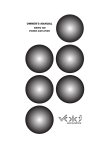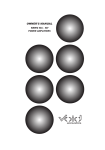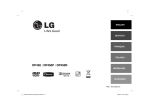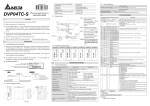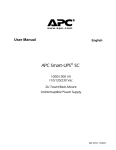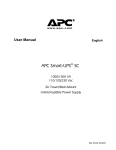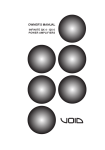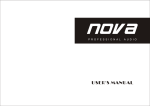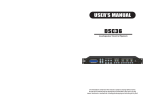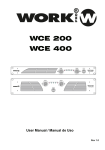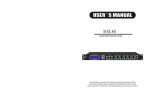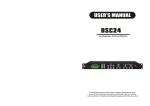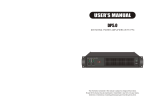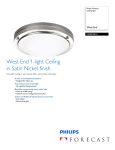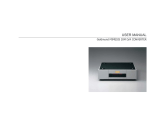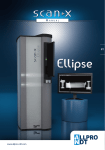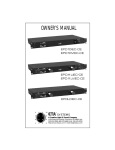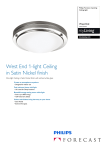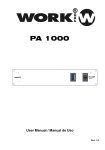Download 4 Installation
Transcript
R DIGISYNTHETIC PROFESSIONAL POWER AMPLIFIER DP45O DP Series Power Amplifier USER MANUAL TABLE OF CONTENTS 1. Safety Instructions 2 2. Introduction 2.1 Welcome 2.2 Unpacking 3 3 3. Description 3.1 Features 3.2 Frontpanel 3.3 Rearpanel 3 4 4 4. Installation 4.1 Stereo 4.2 Mono 4.3 Additional Load Protection 4.4 Required AC Mains 6 6 7 7 5. Operation 5.1 Precautions 5.2 Power Indicator 5.3 Protection Systems 5.3.1 Drive Protection 5.3.2 Transformer thermal Protection 5.3.3 Signal Limiting Circuit 7 8 8 8 8 9 6. Specifications 9 7. Service 12 Page 1 The information furnished in this manual does not include all of the details of design and engineering of this particular product; not does it cover every possible application or situation concerning its usage, which may occur during the installation, operation or maintenance of said DIGISYNTHETIC product. IMPORTANT THE PRODUCT REQUIRES CLASS 2 OUTPUT WIRING. CAUTION TO PREVENT ELECTRIC SHOCK, DO NOT REMOVE TOP OR BOTTOM COVERS. NO USER SERVICEABLE PARTS INSIDE. REFER SERVICING TO QUALIFIED SERVICE PERSONNEL. DISCONNECT POWER CORD BEFORE REMOVING REAR PANEL COVER TO ACCESS GAIN SWITCH. Shock Hazard - Do Not Enter Choc Hasard - N*entrent Schocke Hazard - Test Nicht Betrete Urto Hazard - Do Non Entrano WARNING TO REDUCE THE RISK OF ELECTRIC SHOCK, DO NOT EXPOSE THIS EQUIPMENT TO RAIN OR MOISTURE! Magnetic Field CAUTION: Do not locate sensitive high-gain equipment such as preamplifiers or tape decks directly above or below this unit. Because this amplifier has a high power density, it has a strong magnetic field which can induce hum into unshielded devices that are located nearby. This field is strongest just above and below the unit. If an equipment rack is used, we recommend locating the amplifier(s) at the bottom of the rack and the preamplifier or other sensitive equipment at the top. The lightning bolt triangle is used alert the user to the risk of electric shock The exclamation point triangle is used to alert the user to important operating and/or maintenance instructions. Printed on recycled paper. Page 2 2 Introduction 2.1 Welcome Thank you for choosing DIGISYNTHETIC CO.LTD professional audio product. You have joined a growing group of audio professionals who have turned to DIGISYNTHETIC for the most advanced audio amplification products available. So welcome to the DIGISYNTHETIC family! All DIGISYNTHETIC products have been designed, engineered and manufactured to meet the demands of even the most critical sound reinforcement professional. Please read this manual carefully. It contains important and helpful information to enable you to get the DIGISYNTHETIC performance out of your new product. If you plan to use this amplifier in either of the 2 available Mono modes, please refer to section 2.2 1.1 Unpacking Please unpack and inspect your new amplifier for any damage that may have occurred during transit. If damage is found, notify the Transportation Company immediately. Only you, the consignee, may initiate a claim with the carrier for damage which occurred during shipment. Remember to save all packing materials in the unlikely event your unit should ever need to be returned to the factory for service of any kind. 3 Description 3.1 Features □Rugged, road-worthy professional power amplifier. E.I.A. Standard 19" (48.3cm) rackmountable chassis. □ DP Series "Logic Output " circuitry generates large voltage swings while avoiding electrical stress on the output stages. This results in low distortion and high reliability. □ Front panel power switch with turn-on delay for loudspeaker protection. □ Patented Output Device Emulation Protection keeps the amplifier working under extreme conditions. □ High damping factor provides superior control over low frequency drivers for a clean, accurate low end. □ Safe with any load. Bridge-Mono and Parallel-Mono modes offer optimal loadmatching performance. □ Complete protection against shorted outputs, mismatched loads, overheating, DC input/output and high frequency overload, full internal fault protection. □ Balanced XLR inputs with balanced direct XLR output. Optional barrier block input connectors are available with the PM-BB accessories. □ Efficient heat sinks and self-contained forced air cooling system, dissipate heat quickly and evenly for extra amplifier protection and greater power output. Page 3 3.2 Front panel Indicators CH.2 CH.1 Power Switch Ch1. Level Control Ch2. Level Control 3.3 Rear panel MODE SWITCH AC 220V ±10%/ 50Hz-60Hz 1-Ch.1 Output Input 2-Ch.2 Output Input Page 4 Binding Post andSpeakon Output Connectors Power cord 4 Installation Installation Always reduce volume by turning level controls fully counterclockwise when either connecting or disconnecting cables to the amplifier. This reduces the chance of an audio "spike" that could possibly cause loudspeaker damage.The guidelines below are provided to help you get your amplifier installed and ready to go quickly and easily. Be sure to follow the instructions in Sections 2.1 and 2.2 for the selected mode of operation. Additional information on input sensitivity, load protection and required AC mains is provided in Section 2.3. 1. Install the amplifier in a standard 19-inch (48.3 cm) rack, or place it on a stable surface. The mounting dimensions are 19-inch (48.3 cm) wide, 3.5-inch (8.9 cm) tall and 17.7-inch (44.9 cm) deep behind the mounting surface. IMPORTANT! ALLOW FOR ADEQUATE VENTILATION. 43.5cm AIR FLOW AIR FLOW IMPORTANT: Be sure the back of the amplifier is supported AMPLIFIER (TOP VIEW) AIR FLOW AIR FLOW FRONT OF AMPLIFIER Fig.2.4 Do Not Block Air Flow Page 5 2. Use high-quality loudspeaker cables to connect the load to the amplifier's outputs. Do not use shielded cable. 3. Use shielded cables to connect audio sources to the amplifier's inputs. Either balanced or unbalanced wiring can be used as shown below.(Barrier block input connectors are available with the PM-BB accessories). BALANCED GND - 1 2 3 SHIELD 1 2 + FROM PREAMPLIFIER INPUT UNBALANCED + 3 + FROM PREAMPLIFIER INPUT + SHIELD SHIELD 4.1 Stereo 1. Turn down the level controls (fully counterclockwise) and turn off the amplifier. 2. Set the back panel Stereo/Mono switch to Stereo. 3. Connect the input and output cables . 4. Turn on the amplifier and adjust the level for each channel using the front panel level controls. 4.2 Mono Your amplifier's Mono modes provide double the power of the Stereo mode in a single channel. In Bridge-Mono mode, the outputs are wired for twice the output voltage. In Parallel-Mono mode, the inputs are paralleled to link the two channels. Bridge-Mono mode is provided for loads with impedance greater than 4 Ohms. Parallel-Mono mode should be used with loads of 4 Ohms . Bridge-Mono 1. Turn down the level controls (fully counterclockwise) and turn off the amplifier. 2. Set the back panel Stereo/Mono switch to Bridge-Mono. 3. Connect the input and output cables. Only channel 1 input is used. 4. Make sure the load is balanced (neither side shorted to ground) and do not use the black (-) binding posts. 5. Turn on the amplifier and adjust both level controls. Parallel-Mono 1. Turn down the level controls (fully counterclockwise) and turn off the amplifier. Page 6 3. Connect the input and output cables as shown in the Only channel input is used. 4. Turn on the amplifier and adjust both level controls. CAUTION: Never strap the two red output terminals together (in parallel). Never connect either red output terminal to chassis ground. IMPORTANT: The channel 2 level control will remain illuminated when operating in Parallel/M-ono mode. 4.3 Additional Load Protection To protect against excessive power, a fuse can be added in series with each loudspeaker cable. A single fuse can protect the entire system, or can be used for each driver. High frequency drivers (tweeters) are usually more sensitive to large voltage peaks, while low-frequency drivers (woofers) are typically most sensitive to the heat from average RMS output power. To protect your tweeters, we recommend that you use a high-speed instrument fuse like the Little fuse 361000 series. To protect your woofers, we recommend using a slow-blow fuse that more closely represents the thermal response of your woofer. Use Figure 2-6 to find the correct value for either type of fuse. 4.4 RequiredAC Mains All DP Series amplifiers are shipped with an appropriate line cord and plug. When possible, use a power receptacle on a dedicated circuit; and always, make sure it will provide the correct voltage and sufficient current. We do not recommend operating your amplifier with voltages greater than 10% above or below the unit's rated voltage. For example, if your amplifier is rated for 220 VAC, the line voltage should not exceed 240 VAC. CAUTION: Connect unit only to a proper supply. Use only three wire cord which is provided with unit. 5.operating instruction 5.1 Precautions Although your amplifier is protected from external faults, the following safety precautions are recommended: 1. There are important differences among the Stereo, Bridge-Mono and Parallel-Mono operating modes. Please refer to Section 2 for additional information. 2. WARNING: Do not change the position of the stereo/mono switch unless the amplifier is first turned off . CAUTION: Never strap the two red output terminals together (in parallel). Never connect either red output terminal to chassis ground. Also, make sure the Stereo/Mono switch is set to the proper position. 3. Use care when making connections, selecting signal sources and controlling the output level. Page 7 4. Do not short the ground lead of an output cable to the input signal ground. This will form a ground loop and may cause oscillations. 5. Do not operate the amplifier from AC mains in excess of 10% variation above or below the selected line voltage, and only at the specified line frequency. 6. Never connect the output to a power supply output, battery or power main. Such connections may result in electrical shock. 7. Tampering with circuitry by unqualified personnel or making unauthorized circuit changes may be hazardous and invalidates warranty. Remember DIGISYNTHETIC Audio INC., is not liable for any damage that results from overdriving other system components. 5.2 Power Indicator When illuminated, the green power indicator (the volume control) shows that the amplifier has been turned on. It is driven only by the low-voltage power supply and does not indicate the status of the high-voltage supply. 5.3 Protection Systems DP Series amplifiers have extensive protection systems, including TPC, protection, drive protection, transformer thermal protection, and fuses or circuit breakers that protect the power supplies. 5.3.1 Drive Protection The Drive Protection System temporarily removes output drive to protect the amplifier and its loads. Drive Protection System can be activated in two situations. First, if dangerous subsonic frequencies or direct current (DC) is detected in the amplifier's output, the unit will activate its DC/low-frequency protection circuitry, which puts the amplifier in Drive Protection mode. This mode protects the loads and prevents oscillations. The unit resumes normal operation as soon as the amplifier no longer detects dangerous output. Although it is extremely unlikely that the DC/lowfrequency protecti-on system will ever be activated, improper source materials like subsonic square waves or input over-loads, that excessively clip the input signal, can activate this system. The amplifier's protection system will activate the amplifier's Drive Protection mode in rare situations where heavy common-mode current is detected in the output. The unit should never output heavy common-mode current unless its circuitry is damaged. Activating Drive Protection mode helps prevent further damage. 5.3.2 Transformer Thermal Protection All DP Series amplifiers have Transformers Thermal Protection. This protection is activated in unusual situations where the unit's transformer temperature rises to unsafe levels. Under these abnormal conditions, the unit will removes output drive to protect amplifier.. The fan will continue to run in all units. The amplifier will return to normal after it cools to a safe temperature. It is very unlikely that your DP Series amplifier will ever activate its Transformer Thermal Protection as long as it is operated within rated conditions. Page 8 5.3.3 Signal Limiting Circuit This internal limiting circuit automatically reduce gain because of a significant deviation between input and output signal flow, preventing occurrence of gross non-linearity conditions inside the amplifier caused by overdrive, overload or defect, and keeps the signal shape unaltered under any conditions. The circuit keep signal flow distortion under 0.5%, and thus guarantees clean sound and effective speakon protection. 6. Specifications All amplifier specifications apply to the following settings: Stereo mode with 8-ohm loads and an input sensitivity of 32dB, unless otherwise specified. Power Specification Output Power: The following specifications are guaranteed minimums for standard 1 kHz power. For more information, see the power matrix in Figures 3.1 through 3.2 (DIGISYNTHETICimum average power @ 0.1% THD +N). Heatsink temperature Temperature Protect Circuit (TPC) 90 c 80 c 70 c 60 c 90 C Mute the signal Automatic Out put the signal 80 C At 75° C 60 C TPC Limiter active DIGISYNTHETIC. fan speed 50 c 40 c CHANNEL 1 LEVEL CONTROL CHANNEL 2 LEVEL CONTROL 30 c 20 c 10 c Fig.2.1 Front Panel Level Control The following diagram illustrates the actions taken by the Thermal Management System: Min. fan speed, TPC normal Fan speed 0 c Amplifier: DP Series Fig.2.2 TPC Load Impedance: Safe with all types of loads. Rated at 4 to 8 ohms in Stereo, 4 to 8ohms in Bridge-Mono and 4 to 8 ohms in Parallel-Mono mode. Required AC Mains: Current, frequency and voltage requirements are provided on each unit's back panel. All models draw 90 Watts or less at idle. DP450: (220/50Hz) Draws up to 10 amps of current. AC Connector: An appropriate AC line cord and plug are provided. 110/220 VAC, 50Hz/60Hz units have a standard 3-wire, 15-amp grounded connector (NEMA 515P). Controls Power: A front panel rocker switch is used to turn the amplifier on and off. Level: A front panel rotary potentiometer for each channel is used to control the output level. Page 9 Stereo/Mono:A three-position back panel switch is used to select Stereo, Bridge-Mono or Parallel-Mono mode. Input/Output Data Input Connector: Balanced XLR connector. Input Impedance: Nominally 20k ohms, balanced; 10 k ohms, unbalanced. Output Connector: Two sets of color-coded 5-way binding posts (for banana plugs, spade lugs or bare wire) and two sets of speakon connectors. Output Impedance: Less than 10 milliohms in series with less than 2 microhenries. DC Output Offset: Less than 10 millivolts. Output Signal Modes Stereo: Balanced, two-channel. Bridge-Mono: Balanced, single-channel. Channel 1 inputs are active; Both channel volume controls are available. Parallel-Mono: balanced, single-channel. Channel 1 inputs are active; Both channel volume controls are available. Protection DP Series amplifiers are protected against shorted circuits or mismatched loads, overloaded power supplies, excessive temperature, chain destruction phenomena, input overload and high frequency blowups. They also protect loudspeakers from input and output DC and provide protection from turn-on/turn-off transients. If operating conditions are unreasonable, the patented circuitry proportionally limits the drive level to protect the output transistors, particularly in the case of elevated temperature. A thermal switch imbedded on the heat-sink protects the output device from overload. In the rare event that a transformer overheats, the thermal switch turns the power off, waits until the unit has cooled to a safe temperature and then resets itself. Turn On: Five second delay with no dangerous transients. Contact DIGISYNTHETIC Audio Inc. if you need to change the delay. Construction Durable black finish on steel chassis with special panel to front panels. "flow-through" ventilation from rear Cooling: Internal heat sinks and two 80mm high speed low noise cooling fan with auto speed-control forced-air cooling for rapid, uniform heat dissipation. Page 10 Dimensions: Standard 56 cm rack mount width (ElA RS-310-B), 15 cm height and 47 cm depth behind the mounting surface. Approximate Weight: Center of gravity is 10 inches (25.42 cm) behind front mounting surface. In an effort to provide you with as much information as possible about the high power-producing capabilities of your amplifier, we have created the following power matrices: need to change the delay. DP450 300W 500W 900W 300W 500W 20Hz-20kHz+/_0.5dB +0dB/-0.3dBfrom 20Hz to 20kHz at 1 watt +/_0.1degrees from 10Hz to 20kHz at 1 watt >98dB ≤0.01% Rated Power@8Ω ≤0.01% Rated Power@8Ω 1kHZ >300@1kHz/8 ohms >60dB 40v/μs (Stereo) 10K/20K ohms, unbalanced or balanced 56cm x 47cm x 15cm ~220V 50/60Hz FUSE:T10A FUSE:T12A FUSE:T15A Page 11 5. Service This unit has very sophisticated circuitry and should only be serviced by a fully trained technician. This is why each unit bears the following label: CAUTION To prevent electric shock, do not remove covers. No user serviceable parts inside. Refer servicing to a qualified technician. 5.1 Worldwide Service Service may be obtained from your local authorized agent. To obtain service, simply present your sales receipt as proof of purchase along with the defective unit to an authorized agent. They will handle the necessary paperwork and repair. Remember to transport your unit in the original factory packaging. 1. To ensure the safe transportation of your unit to the authorized agent, ship it in an original factory-packing container. 2. Do not ship the unit in any kind of rack. Ignoring this warning may result in extensive damage to the unit and the equipment rack. Accessories are not needed. Do not send the instruction manual, cables and any other hardware. Page 12













